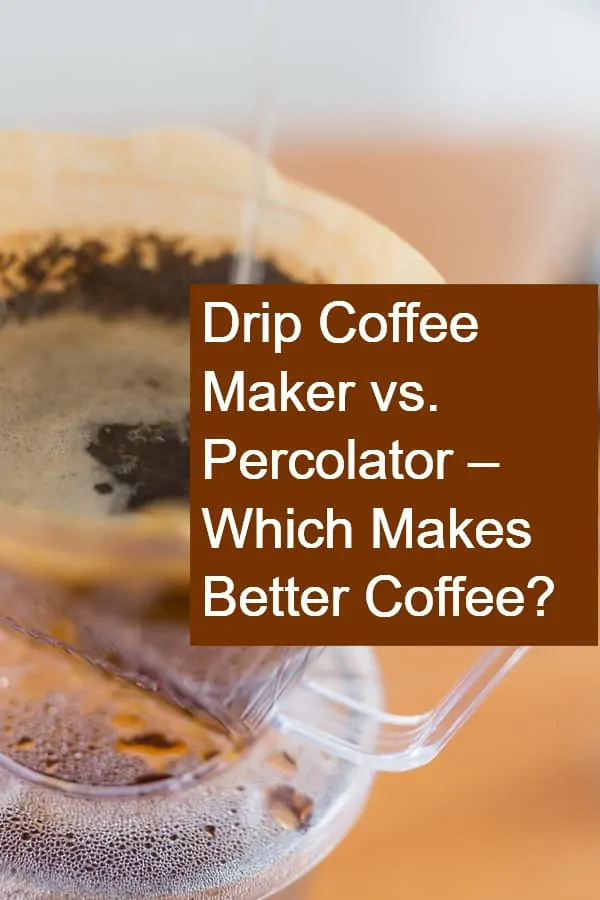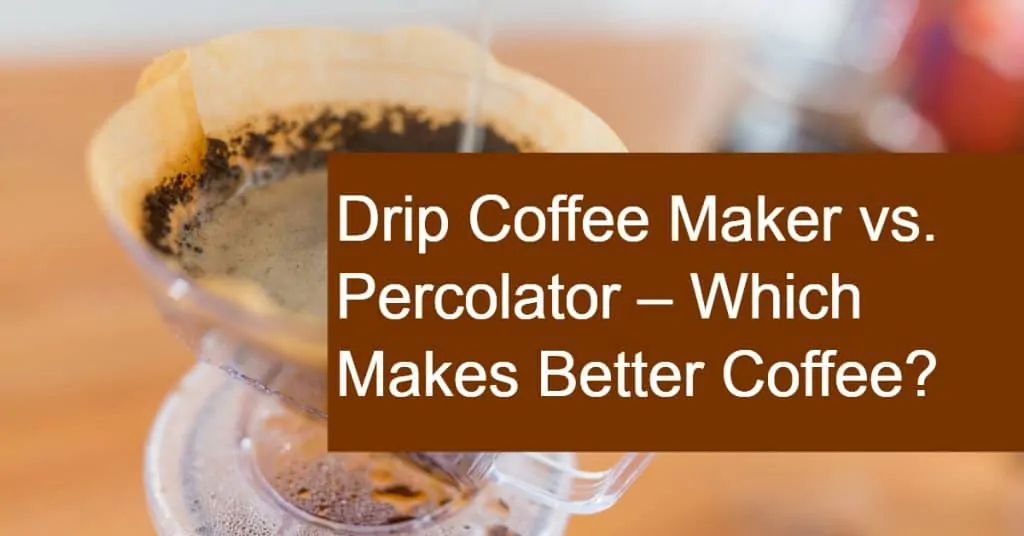Every coffee lover knows that the difference in your preference of coffee isn’t just in the beans and where you get them; it is also in the preparation. Some people like an espresso, some like an Americano, and some like it dripped, some like it pour-over and some like it made in a percolator. As you can see, there are countless ways to brew that delicious dark brown, aromatic liquid for a great cup of coffee to jolt you awake in the morning. Let’s specifically have a look at drip coffee makers vs. percolators.
Coffee aficionados won’t hesitate for a second to tell you their exact preferred brewing methods and why they prefer it so. But, what about the rest of us amateurs when we want to brew coffee? Why do some people prefer drip coffee and some prefer the percolator – what exactly is the difference? Below, we take an in-depth look at the difference between these two brewing methods and brews to understand what exactly they are, which is better, and why?
What Is Percolator Coffee?
A percolator is a piece of equipment used to brew coffee. It uses simple mechanics and physics for the brewing process and has withstood the test of time, proving its ability and results as a coffee maker.
The coffee percolator first came around in the early 1800s and was modified over the years until it was first patented in the US by James Nason. The percolator has been a popular coffee maker because of its ease of use, portability, and durability.
The percolator itself can either be a stovetop percolator or an electric percolator. The coffee maker consists of the metal body which makes up the entire inner chamber of the coffee machine.
Then there is a vertical pump tube; this tube is where heated water is pushed up through condensation and the water is carried to the top. At the top is a spreader sheet, which helps disperse the water from the pump tube in a shower like fashion onto the coffee grounds.
The ground coffee is placed in a basket, which is a perforated part that sits toward the top of the main chamber and works as a filter for the coffee; as the water from the pump tube drips onto the basket it filters the brewed coffee back into the main chamber.
As the heat sources remain, the percolated coffee, or perked coffee, is brewed and re-brewed using the same water in a recycled fashion until the desired strength of the coffee is reached. Percolators often have clear cover knobs so you can see the color of the coffee on the inside. Where electric percolators will stop brewing on their own, it is good to keep an eye on the coffee being brewed in stovetop percolators.
This kind of coffee maker is a popular choice for those who go camping or spend a lot of time outdoors or simply love the stronger perked coffee.

What Is Drip Coffee?
About a century after the percolator came into being, the American markets were introduced to the drip coffee maker. The drip coffee maker is an extremely popular choice of coffee brewer, especially for people who have limited time and want something that can work in the background while they get other tasks completed. Drip coffee makers consistently brew coffee quickly, with the same results every time, as long as settings and rations remain the same.
Drip coffee makers are electric and consist of a few different parts that work together to brew the coffee. There are a lot of intricate fuses and cables that make up the drip coffee maker but there are a few essential parts and their functions that we will discuss below:
The coffee maker is made up of a heating element, which it uses to heat up the water and it usually made up of something similar to the filament of a light bulb or those you find in toasters. Next, there is a ceramic plate, which is also heated to ensure the coffee remains warm in the carafe; the carafe, made of glass, goes on top of the ceramic heating plate.
There are pipes that the water is heated in and taken to the top through condensation much like a percolator. At the top is a basket in which a filter is filled with the coffee grounds. The heated water goes through the coffee grounds and “drips” into the carafe, giving this kind of machine its name.
Drip coffee makers are quick and can make larger batches of coffee, which is why they are often used for commercial use as well as home use.
What is the difference between white and brown coffee filters?

Which Is Better: Drip or Percolator Coffee Makers?
The reason why both ways to make coffee are popular is that they each have their benefits. At the end of the day, it all comes down to personal preference whether you like percolated coffee vs drip coffee better. The preference could come in taste, the effort each process takes, and the cost of percolator vs drip coffee maker.
For taste, drip coffee will give you a lot more of a subtle taste. The water goes through the coffee grounds one time at a fairly quick rate, meaning it only extracts the minimal flavor from the coffee grounds. This leaves you with a light to medium brew in your carafe.
When you’re brewing coffee with a percolator, with the same amount of coffee, you can be left with a much darker and more intense percolator coffee brew. Because the water goes through the same grounds over and over again, it extracts a lot more flavor, but some also consider this over-extraction, sometimes leaving you with a strong, aromatic cup of coffee, and other times with a burnt, bitter coffee. That can both be the case whether you use a stovetop percolator or an electric percolator.

With the effort, both machines take practically the same amount of effort. The automatic drip coffee maker is a set-it-and-forget-it kind of process. A stove-top percolator needs you to keep an eye on it and remove it from the heat when you have reached the desired percolator coffee intensity.
Similarly, you have to switch off an electric percolator once the level of desired intensity of the perked coffee is reached. Drip coffee machines also work a lot faster than percolators.
The cost can vary drastically among each category of the coffee maker. Stovetop percolators can cost anywhere from a mere $8 to $20 if you go for a straightforward, standard version, but the electric versions can go up to $200 depending on the abilities. The prices for percolators can go even higher if you look for ones that can produce larger batches of coffee.
When looking at drip coffee makers, you will see a much larger range in types, thus, in prices too. A regular drip coffee maker will only set you back around $10. If you increase the quality, you can get drip coffee makers under $50, but mid-range brewers can go up to $500. If you’re looking for something really fancy, with a touch screen and a built-in coffee grinder, it can cost you up to thousands of dollars.
How to Make Good Percolator Coffee
If you are a strong coffee lover and want to get a rich, aromatic, and intense cup of coffee, a percolator is the best choice for you. Making a coffee in an electric or stovetop percolator coffee maker aren’t very different processes, but require different levels of attention. Here is the common process to get a delicious cup of joe:
- Measure your coffee depending on the volume of your final brew. 1oz of whole beans for every 17oz of water is a good place to start.
- Grind your coffee beans in a burr grinder into a medium to coarse grind.
- Remove the tube and basket from the main chamber
- Add cold water to the main chamber of the percolator according to your coffee
- Reassemble your percolator and add the coffee grounds to the basket
- Switch on the percolator or turn on the stovetop to low and let the coffee slowly brew.
- The process takes between 5 to 10 minutes. Keep an eye on your coffee and stop the process when you have reached your desired color.
- Remove the percolator from the heat source or switch it off – keep in mind that it will be very hot, so, be careful!
- Don’t forget to remove the coffee grounds before pouring yourself a cup of this delicious, fresh brew!
How to Use a Stovetop Coffee Percolator?
A stovetop percolator uses the same process mentioned above. The only difference is that you have to watch your coffee, making sure that you do not over brew it, which will lead to an over-extraction of flavor from the ground coffee, resulting in a bitter and undrinkable cup of coffee.
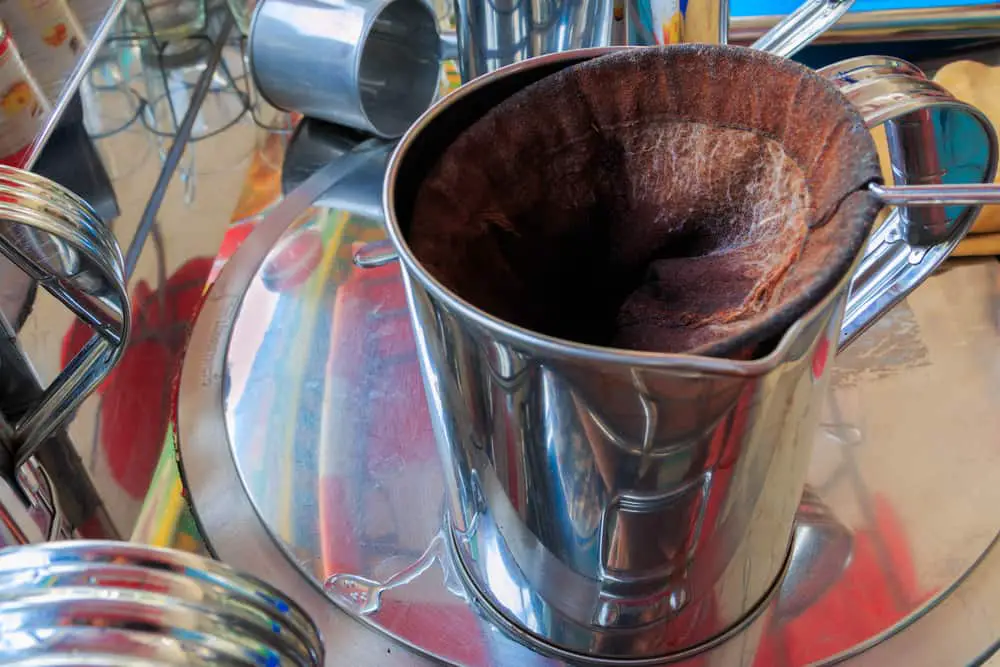
What Is The Best Coffee To Use In A Percolator?
There is definitely a right and wrong coffee to put into a percolator. Since percolators brew strong cups of coffee, you want to avoid dark roasts; dark roasts in a percolator will result in a bitter cup.
Light roasts also don’t work great in percolators, because they end up giving you a watery cup of coffee; light roasts lose their flavor in the process. The best kind for percolators is a medium roast; they maintain their aroma and flavor during the percolating process.
What Coffee Grind Do You Need For A Percolator?
The best setting for grinding your coffee for a percolator is medium-coarse (What kind of grinder should you use? – Burr vs Blade Grinder Evaluation!). The reason for this is because of the way a percolator works.
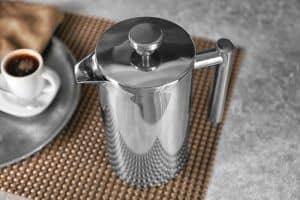
Percolators, as it is, make stronger cups of coffee because water is recycled over the grounds extracting a lot of flavors. When the coffee is ground too fine, you are exposing more surface area of the coffee to the water, allowing it to extract more oils and flavor from the coffee.
You might end up with a cup that is too strong and bitter. Plus, these small coffee grounds can filter through the strain and end up floating in your coffee.
If your coffee grounds are too big, you might end up wasting your precious coffee. The water will not be able to extract enough flavor from the grounds, leaving you with a mild or light cup of coffee; the exact opposite of what you want from a percolator.
Can You Use Drip Coffee Grounds in a Percolator?
A drip coffee maker works by pushing hot water fairly quickly through coffee grounds. This way of coffee brewing makes it so the water only goes over the grounds one time. It needs to extract as much flavor as it can as it passes through the coffee.
Drip coffee grounds are from a medium to a fine grind to expose as much surface area to the water as possible in order for it to extract the oils from the coffee. As explained above, this kind of grind won’t work for percolators.
Is Perked Coffee Bad For You?
Perked coffee is not bad for you; it can just taste bad sometimes!
If you learn to brew in a percolator properly, you won’t get that over-extracted bitter taste that most people associate with something bad. Another tip to ensure you aren’t getting a bad cup of coffee is by purchasing a percolator that has stainless steel on the inside instead of aluminum. You won’t get that tin-like taste in your final cup.
Final Thoughts
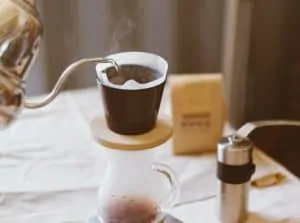
There is a reason why percolator coffee has been a favorite for years and continues to be a staple item in many kitchens. Percolators can make a delicious cup of strong coffee if you know how to work them properly.
Drip coffee makers to make coffee have also gained popularity for those who enjoy a quick brew of light, to medium flavored coffee. Either way, the way you brew comes down to personal preference. Go out and taste the differences between drip coffee makers and percolators to see what actually floats your boat!
Share It!
Please use the image below to share the overview and comparison of percolator vs drip coffee maker on your social media channels!
